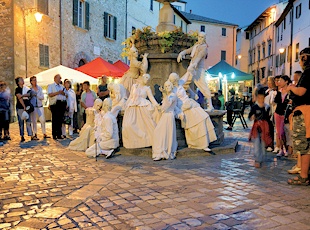The Strength Behind the Style

Italy is famous for a number of things. Pizza, fashion, architecture and supercars spring to mind, as does soccer – the country is even shaped like a boot! Transport, however, does not. But RICHARD MACASKILL looks into the trucking and transport industry of Italy, and discovers that commercial vehicles are also one of the pillars of the country
Italy’s image is that of being stylish, delicate and romantic. The image of trucking is the complete opposite: rough, dirty and oily. Even in Italy this vital industry lies in stark contrast with the designer coffee bars that line the sidewalks of the country’s cobbled streets. However, each and every country needs a driving force behind it, something to keep the wheels of the economy turning, and Italy is no exception.
Trucking is hugely important in any country. To put the importance of Italian transport into perspective, South Africa’s six major ports are located in Durban, Richard’s Bay, Saldanha Bay, East London, Port Elizabeth and Cape Town. Italy has 43 major sea ports, one of which is the second largest port on the Mediterranean Sea. Of course, having so many ports in one country means that Italy is a transport hub for its landlocked neighbours in Europe. That being said, while approximately 85% of Italy borders the surrounding seas, the northern border – the remaining 15% – faces a challenge of the opposite variety. Italy’s border with France, Switzerland, Austria and Slovenia is geographically marked by the Alps.
THE GEOGRAPHICAL CHALLENGE
One of the problems road transport faces in Europe is a lack of access into Italy. This lack of access is due to the country being bordered either by sea or by mountains. This highlights the importance of the transport industry in Italy as a whole, both in terms of border efficiency and the care that needs to be taken during Alp crossings. There are a number of difficulties involved in crossing the Alps, and while there are tunnels to aid in solving these problems, these tunnels present safety risks of their own. In 1999 there were 50 deaths in two of these tunnels because of accidents. After these deaths, the tunnels were closed for almost three years, creating massive problems for Italian truck drivers.
 Transport through the Alps came under immense strain as trucking is not something that can be temporarily stopped. It simply has to function. The closing of these two tunnels led to action in the form of truckers blocking Alpine crossing routes in 2002. To avoid the risk of Italy’s economy suffering because of the poor safety of these tunnels, Italian transporters wanted to emphasise the importance of trucking and transport in the country.
Transport through the Alps came under immense strain as trucking is not something that can be temporarily stopped. It simply has to function. The closing of these two tunnels led to action in the form of truckers blocking Alpine crossing routes in 2002. To avoid the risk of Italy’s economy suffering because of the poor safety of these tunnels, Italian transporters wanted to emphasise the importance of trucking and transport in the country.
Previously, in 1997, Italian truck drivers went on strike over a wage dispute. The strike was a massive one and is said to have involved 99% of the transporters in Italy. This caused severe shortages of food, fuel and medicine across the country. Italy almost came to a standstill. Clearly, the importance of transport throughout Italy was successfully highlighted as the country experienced a dramatic slowdown when the trucks were not running.
THE DRIVING FORCE
This makes it clear that transport is crucial to the successful functioning of Italy as an economic entity. Italy is a hugely popular tourist destination and, as such, it is a country in which transport – both freight and passenger – must be in great shape.
Italy’s transport industry is a big one, and trucking makes up a substantial part of the country’s transport. The industry as a whole generated turnover of approximately €119.4 billion (R1 380 billion) in 2004 and employed 935 700 people in over 153 000 enterprises and businesses. To emphasise both the size and the efficiency of Italy’s transport industry, it is worth noting that Italy even has 1 477 km of navigable inland waterways in the forms of rivers and channels.
Railways make up a large part of the transport industry in Italy, but this by no means indicates that trucks play a peripheral role. There are over 668 000 km of serviceable roads in Italy and, of the 34 667 million vehicles that made use of the national road network in 2005, 4.015 million of them were commercial vehicles.
As far as commercial vehicle production and manufacturing goes, Italy may seem a bit limited, but three of the Italian commercial vehicle manufacturers, Iveco, Astra and Fiat, are hugely successful both in and out of the country. In fact, Fiat, through its various subsidiary companies (commercial and passenger vehicles), represents over 90% of automotive production, sales and exports in Italy.
Iveco, one of Italy’s major commercial vehicle manufacturers, produces trucks such as the Eurocargo, the Trakker and the Stralis, arguably some of the best trucks available today. Furthermore, Astra makes some of the strongest heavy-duty trucks the world has seen.
Italian ties spread far and wide in the commercial vehicle industry. Marcopolo, which manufactures buses on the other side of the world in Brazil, has Italian ties through its name. The buses come from a very Italian part of Brazil and the name harks back to the famous Italian explorer and traveller.
A GREENER FUTURE
There is a move all over the world to a much cleaner automotive industry as a whole. This is particularly the case in Europe and is also true of Italy. With the country being so important to the entire automotive industry, trucking and transport in Italy take on new levels of importance as the greener trucks of the future get ever closer to becoming a reality today.
With trucks and buses of the highest quality and typical Italian style coming from the country, it is easy to see why transport is such an important driving force behind the scenes of this fashionable tourist destination.
Published by
Focus on Transport
focusmagsa



